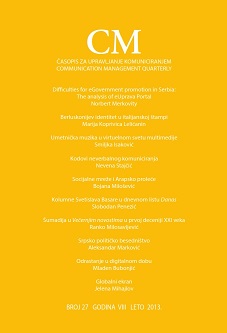Kodovi neverbalnog komuniciranja
Codes of Nonverbal Behaviour
Author(s): Nevena StajčićSubject(s): Theory of Communication, Social psychology and group interaction, Behaviorism
Published by: Fakultet političkih nauka Univerziteta u Beogradu
Keywords: nonverbal communication; nonverbal codes; nonverbal behaviour;
Summary/Abstract: Verbal communication skills are one of the most important prerequisites for communication competence of each individual. It is well known that good communication is the foundation of any successful relationship, whether familial, romantic or professional. A significant part of the communication that takes place between people is nonverbal. Even when people stop speaking, they do not cease to communicate, because their bodies are constantly sending information about themselves. These signals may indicate the current emotional state of the speaker, but they can be misunderstood. Therefore, understanding nonverbal communication can and should be a key to effective communication. The rules of nonverbal communication are acquired through socialization and vary significantly between cultures, and even within the same culture. Verbal code, used in the appropriate syntax, has a denotative meaning. If during verbal communication, we hear a word we do not understand, we can look it up in the dictionary. For interpreting nonverbal communication, vocabulary does not exist. If someone approaches, touches us, is being quiet, or is staring at us, we can only guess the reasons and significance of these moves. Nonverbal communication, no matter how short it lasts, is inevitably accompanied by verbal communication. Nonverbal language can be intertwined with verbal language and may complement it, accent, substitute, repeat or even contradict it. Understanding of nonverbal communication codes is, therefore, a key factor in the process of communication, both among members of the same culture, and between members of different cultures, and as a result it is expected to achieve intentional didactic, economic or political goals. Bearing in mind that codes of nonverbal communication overlap and can confuse the communicators, the aim of this paper is to provide a systematic division of the existing non-verbal codes.
Journal: CM Komunikacija i mediji
- Issue Year: 8/2013
- Issue No: 27
- Page Range: 67-89
- Page Count: 23
- Language: Serbian

